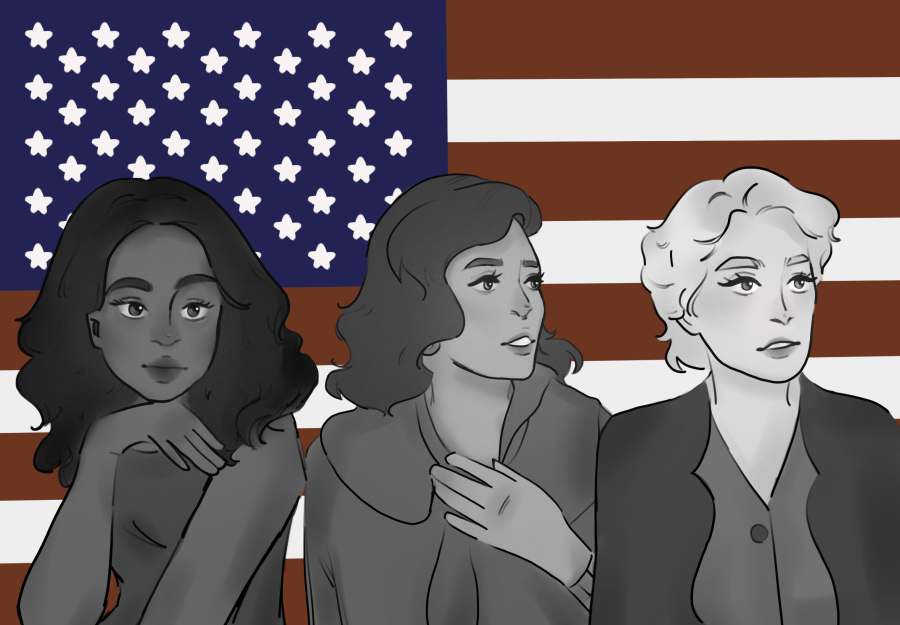On a flight back from Toronto this past summer, I noticed “The First Lady: Episode 2” recommended to me on the infotainment system. Air Canada had apparently neglected to provide Episode 1, but with the APUSH exam still fresh in my mind, the TV show captured my attention. I was hooked.
And after binge-watching all 10 episodes over the summer, I was disappointed to find that a sequel had already been canceled because of lukewarm audience reception. The series, frankly, is criminally underrated.
A historical drama, “The First Lady” follows the lives of three of America’s most unique presidential wives: Eleanor Roosevelt, Betty Ford and Michelle Obama. Despite the confusing meshing of three separate narratives, the distinct personalities and roles of each First Lady is masterfully preserved through their dialogue and apparel. Roosevelt is portrayed as a serious, stately figure who may very well have occupied the Oval Office had she been born in a different time. Ford’s candor, good nature and upbeat personality, visually represented by brightly colored dresses and jackets, contrast sharply with the austere, stern nature of the U.S. government in the 1970s. Obama’s position as both a financially independent, employed woman and a caring mother, juxtaposed with her formal business suits and cozy pajamas, provides fresh commentary on the changing role of women in the contemporary world.
Ultimately, though, the main narrative of the series is feminism and the fight for womens’ rights. The combined stories of the three women create a unique chronicle of the role of women in the U.S.
While Roosevelt’s story is dominated by condescending men who excessively focus on her gender and therefore view her as unqualified to do anything, Obama’s personal narrative hardly features gender as an issue, except for Trump’s election in 2016. The transition between Roosevelt and Obama’s narratives thus provides a testament to the progress women have made over the past 100 years.
But it’s Ford’s story, chronologically sandwiched between Roosevelt and Obama’s, that proves the most gut-wrenching of all. Ford’s life, from her abusive first husband to her addictions to prescription medication and alcohol, represents the sacrifices American women made during the mid-20th century and reminds us how far women’s rights have come since the mid-20th century.
Ford’s flashbacks during her mental breakdowns heavily feature her former jobs as a department store manager and an auxiliary dancer under famed director Martha Graham, perfectly expressing her frustration with her life as a homemaker surrounded by conservative congressional wives. These women have no working experience, are satisfied with their lives as housewives and abhor one of her favorite books, “The Feminine Mystique.”
During one intense argument with her husband, Ford exclaims, “I have stuck by you, I have done everything I was supposed to do! And what do I have to show for it?” Her outburst encapsulates the frustration of many women during her era, who were expected to follow strict social guidelines and stay in the domestic sphere.
But the time she spent in a rehabilitation center and her founding of the Betty Ford Drug and Alcohol Addiction Center represent her hope for the future. By the end of the series, she is again an independent woman with a job and aspirations, representing the growing number of working women in the 1980s and 1990s.
The show is not perfect, though, and I do understand its criticism. The meshing of three distinct stories into one TV series can be confusing, especially considering the frequent flashbacks, even with the help of a timeline to transition between eras.
In addition, the show sometimes tosses viewers into complex historical scenes, requiring so much historical understanding that even the most diligent APUSH student will cry (I myself had to consult Wikipedia more than once). Lots of important characters and events – Frances Perkins, Donald Rumsfeld and North Carolina Amendment 1 to name a few – are thrown at viewers without much context. While the show does a decent job introducing the three First Ladies, important supporting characters are often thrown in unceremoniously, undermining their importance to the plot’s narrative. Once, I asked myself, “How is this random woman important enough to host meetings?” before consulting Google and realizing she was Michelle Obama’s Chief of Staff.
But don’t let the occasional tsunami of historical knowledge or the show’s 41% approval rating on Rotten Tomatoes dissuade you from watching “The First Lady.” Perhaps, if more people watch, the producers might change their minds about a sequel, because the intimate way this series approaches the lives of the most scrutinized women in the United States is unparalleled, and more first ladies deserve to have their story told in this engaging, touching manner.
And thanks, Air Canada, for at least having one episode of the series available to your passengers.



